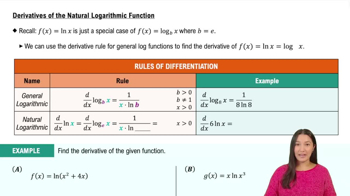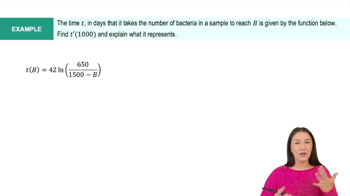Table of contents
- 0. Functions7h 52m
- Introduction to Functions16m
- Piecewise Functions10m
- Properties of Functions9m
- Common Functions1h 8m
- Transformations5m
- Combining Functions27m
- Exponent rules32m
- Exponential Functions28m
- Logarithmic Functions24m
- Properties of Logarithms34m
- Exponential & Logarithmic Equations35m
- Introduction to Trigonometric Functions38m
- Graphs of Trigonometric Functions44m
- Trigonometric Identities47m
- Inverse Trigonometric Functions48m
- 1. Limits and Continuity2h 2m
- 2. Intro to Derivatives1h 33m
- 3. Techniques of Differentiation3h 18m
- 4. Applications of Derivatives2h 38m
- 5. Graphical Applications of Derivatives6h 2m
- 6. Derivatives of Inverse, Exponential, & Logarithmic Functions2h 37m
- 7. Antiderivatives & Indefinite Integrals1h 26m
- 8. Definite Integrals3h 25m
6. Derivatives of Inverse, Exponential, & Logarithmic Functions
Derivatives of Exponential & Logarithmic Functions
Problem 56a
Textbook Question
The energy (in joules) released by an earthquake of magnitude M is given by the equation E = 25,000 ⋅ 101.5M. (This equation can be solved for M to define the magnitude of a given earthquake; it is a refinement of the original Richter scale created by Charles Richter in 1935.)
Compute the energy released by earthquakes of magnitude 1, 2, 3, 4, and 5. Plot the points on a graph and join them with a smooth curve.
 Verified step by step guidance
Verified step by step guidance1
Identify the equation for energy released by an earthquake: E = 25,000 ⋅ 10^(1.5M).
Substitute the values of M (1, 2, 3, 4, and 5) into the equation to calculate the corresponding energy E for each magnitude.
Calculate E for each magnitude: E(1), E(2), E(3), E(4), and E(5) using the equation.
Create a table to organize the values of M and their corresponding energy E.
Use the values from the table to plot points on a graph, with M on the x-axis and E on the y-axis, and then join the points with a smooth curve.
Recommended similar problem, with video answer:
 Verified Solution
Verified SolutionThis video solution was recommended by our tutors as helpful for the problem above
Video duration:
6mPlay a video:
Was this helpful?

 4:50m
4:50mWatch next
Master Derivatives of General Exponential Functions with a bite sized video explanation from Callie
Start learningRelated Videos
Related Practice














